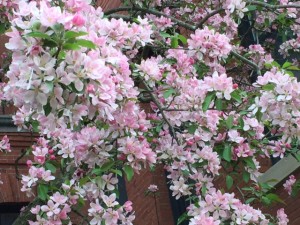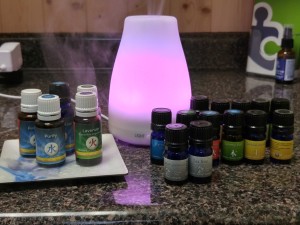
The word “aromatherapy” may at first bring to mind the feeling of being overwhelmed with sickeningly sweet perfumes while walking through a department store or a candle shop. But aromatherapy is quite the opposite. Using the organic, essential oils from flowers like lavender and chamomile, aromatherapy stimulates and sedates the sensory organs without overwhelming them. It works very well as a complement to acupuncture treatments. Herbalists can combine essential oils with jojoba oil to make a synergy massage oil for each patient.
For example, I combine peppermint, lemon, frankincense, and eucalyptus to treat asthma; sandalwood, high-altitude lavender, rose, and bergamot to treat stress; roman chamomile, neroli, rosewood, and geranium to treat menopause; and arnica, clary sage, and patchouli to treat muscular pain.
I was pleasantly surprised when I used 3 drops of Melaleuca (Niaouli – Rocky mountain Oil) to 2 oz of water used for 3 times per day. The nerve pain from the area I had a root canal done went away within a day! I am a big believer after that! Clove Oil is another one you may keep in your medicine cabinet.
Patients can also perform the aromatherapy at home, between acupuncture treatments. When one patient came to see me with severe vertigo, I made a vertigo-relief essential oil for her, stored it in miniature cobalt blue glass bottles with rollers, and asked her to apply it to her wrists whenever she felt an attack coming on. Her symptoms improved quickly.
For another patient, who was very anxious about her upcoming CPA board exam, I made the “mental clarifying, focusing blend” synergy. She used it and said that she was able to concentrate better than she could before using the synergy.
For asthma patients, I provide the asthma-relief synergy mixed with water in spray bottles and ask them to spray the synergy in the room when they are feeling short of breath.
For patients with insomnia, I suggest that they spray the insomnia-relief synergy blend in their bedrooms before they go to bed. These synergies work very well and offer an effective way to treat symptoms naturally. My favorite is “Dreamtime” from Rocky mountain Oil. It works well.
For morning sickness, I recommend my patients to just dab a few drops of lemon on their wrist crease and inhale the scent. It works very well.
I also use arnica and emu oil. Arnica is a homeopathic anti-inflammatory that I use to treat traumatic injury, strained joints, muscles, ligaments, tendons, and lower back pain.
Emu oil (from Thunder Ridge) has healing, anti-inflammatory properties. It increases the circulation to the applied area and works quickly to heal burns, wounds, eczema, psoriasis, and insect bites. I use Emu oil after treating psoriasis patients with acupuncture, and their skin shows a dramatic improvement.
During facial acupuncture treatments, I also apply a warm face mask on top of a paper face mask (with a hint of nourishing powdered Chinese herbs and/or a few drops of lavender essential oil) for 5 to 10 minutes. The face has many important acupuncture points and is very close to the brain; the sense of warmth from the mask sends signals to the sensory cortex to relax quickly, which enables the patient to benefit even more from the acupuncture. This treatment helps patients who have anxiety or insomnia fall immediately into a deep sleep.
I think the best part of using oil is for children’s acute illness like an ear infection, cold, attention disorder, and restlessness sleep. Apply a few drops of peppermint oil on the bottom of feet and massage. Since the bottom of feet have many nerve endings, the benefits of oils are able to carry into the blood stream very quickly. Another effective area is the base of the throat, inside elbows and knees, and the nape of the neck.
One caution – if you happen to drop oils on your skin and want to wipe it out quickly, use the carrier oil like jojoba oil to wipe it out. Water or alcohol are not the proper absorbents to clean up oils.
The three basic essential oils (and their versatile usage):
French Lavender
Acute minor cut or burn – to stop pain and bleeding
Hay Fever – put a drop on palm and inhale slowly
Kill bacteria – mix with water and spray o diffuse in the room
Morning sickness – calm you down
Dry and chapped skin – rub it on or mix with jojoba oil
Calming – rub a few drops on the sole of feet
Insomnia – apply a few drops on the tissue or a cotton ball next to your pillow
Insect bite – put a drop – to reduce swelling
Lemon
Disinfectant –rub one drop on the palm of your hands
Morning sickness – inhale the scent to stop the nausea
Cold sores – rub one drop – eliminate waste from the cells
Corn, callous, wart and bunion – apply a couple of drops before going to bed
Athlete’s foot
Varicose veins – rub a few drops once a day – relieve pressure on the veins
Excess cellulite – rub a few drops – improve circulation and eliminate waste
Cleaning – dishcloth, fixtures, laundry, carpet, counters, dishwasher, butcher’s block
Kill germs – mix with water and spray or diffuse in the room
Peppermint
Boost energy –rub on the wrist crease and inhale the scent
A temporal headache – put it on the finger tip and massage it on the skull of the head
A migraine headache – carefully rub a drop on the eye blow, temple
Stop nausea – put it on the finger tip and rub on the sternum and under the sternum
Mood enhancer – directly inhale or apply on the sole of the 2nd and 3rd toe
Improve concentration and alertness – directly inhale or apply on the sole of the big toe
Relieve pain for acute injury to reduce inflammation
Hot flash / Fever – apply a couple of drops on bottom of feet
Stop hiccups – apply on the neck on the spine (behind the throat)
Stop itching – not used for broken skin or cut
Heart burn – add a drop to a warm water and drink a cup of tea
Poison ivy – diluted with jojoba oil and apply on the affected area
Other Essential Oil Suggested Uses:
You do not need a lot of essential oils for each time you use. You can use only a few drops of oils at a time and apply to the skin. I recommend you to dilute with a carrier oil for 1-2 drops of essential oil with one teaspoonful of carrier oil. However, you are going to treat a specific area like a rash or sore muscles, you may apply a few drops to the spot. You may use a drop of peppermint oil apply to the temporal area if you are having the headache without diluting with carrier oils.
- A headache – a drop of peppermint oil on your temples
- Rash – 1 drop of lavender + 1 drop of tea tree oil
- Restless sleep – 1-2 drops of lavender + patchouli on a cotton ball or on your pillow case
- Stuffy nose – Eucalyptus Globulus
- Gout – Celery seeds
- PMS (painful period) – dab Clary Sage + Geranium
- Cold sores – Tea Tree oil
- Palpitations – Valerian Root
- Boost immunity – Black Cumin
- Amenorrhea (no period) – Carrot Seed
- ENT problems – Cold/Flu/Sinus infection – put a few drops of
 Eucalyptus Globulus or Frankincense into your humidifier (warm air humidifier by Vapor has a little pocket where you can put oils in it)
Eucalyptus Globulus or Frankincense into your humidifier (warm air humidifier by Vapor has a little pocket where you can put oils in it) - Deodorant – sandalwood + lavender + fragrance-free cream, lotion, gel, skin toner
- Laundry – 5 drops of lavender, lemon, sandalwood, neroli as to add a nice aroma
- Air freshener for your car, room, bathroom – mix a couple of your favorite oil with water and spray
- Kitchen sink (drainage) smell – 5 drops of lemon
- Energize the room – citrus oil
- Purify the room (coughing ) – Frankincense
If you are looking for the high-quality Essential Oil, go to this site (Rocky mountain Essential Oils) to order online.
And diffuser – this is the one I use in my clinic. It changes the color. Very pretty to look at it.